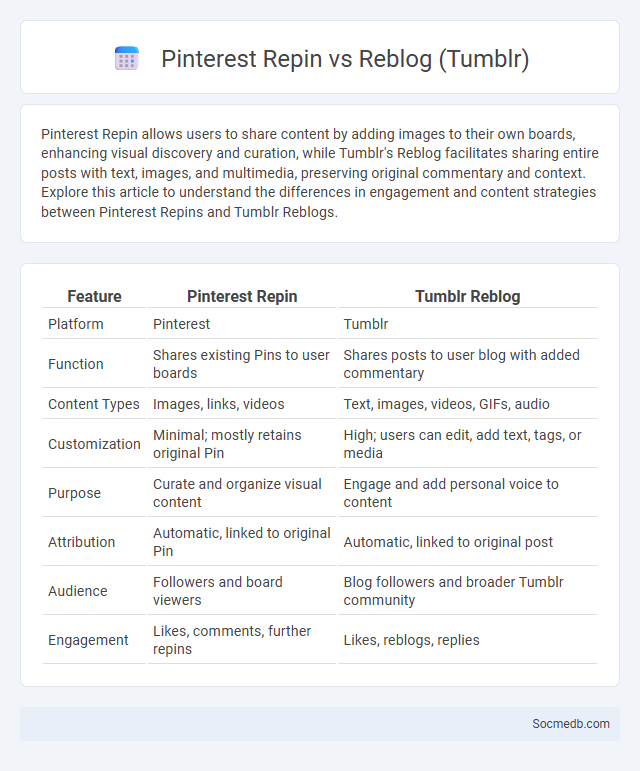
Photo illustration: Pinterest Repin vs Reblog (Tumblr)
Pinterest Repin allows users to share content by adding images to their own boards, enhancing visual discovery and curation, while Tumblr's Reblog facilitates sharing entire posts with text, images, and multimedia, preserving original commentary and context. Explore this article to understand the differences in engagement and content strategies between Pinterest Repins and Tumblr Reblogs.
Table of Comparison
| Feature | Pinterest Repin | Tumblr Reblog |
|---|---|---|
| Platform | Tumblr | |
| Function | Shares existing Pins to user boards | Shares posts to user blog with added commentary |
| Content Types | Images, links, videos | Text, images, videos, GIFs, audio |
| Customization | Minimal; mostly retains original Pin | High; users can edit, add text, tags, or media |
| Purpose | Curate and organize visual content | Engage and add personal voice to content |
| Attribution | Automatic, linked to original Pin | Automatic, linked to original post |
| Audience | Followers and board viewers | Blog followers and broader Tumblr community |
| Engagement | Likes, comments, further repins | Likes, reblogs, replies |
Understanding Pinterest Repin: Features and Functions
Pinterest repin is a core feature that allows users to share and redistribute others' pins to their own boards, enhancing content visibility and engagement. This function enables seamless content curation, helping users organize ideas and inspirations while boosting the original pin's reach through network effects. Understanding Pinterest repin mechanics improves social media strategies by leveraging viral sharing and maximizing audience interaction.
What is a Tumblr Reblog? Key Differences Explained
A Tumblr reblog is a feature allowing users to share and repost content from other users on their own blogs, preserving the original post's format and enabling commentary or added tags. Unlike retweets on Twitter or shares on Facebook, reblogs maintain a visible chain of source attribution, fostering collaborative content discovery and community interaction. This functionality emphasizes content redistribution while highlighting the original creator, making it distinct from simple sharing mechanisms on other platforms.
Comparing Content Sharing Mechanisms
Social media platforms employ diverse content sharing mechanisms, including direct posting, stories, and private messaging, each designed to maximize engagement and reach. Platforms like Facebook and Instagram enable users to share multimedia content seamlessly with followers or specific groups, while TikTok emphasizes short video sharing with algorithm-driven discovery. Understanding these mechanisms helps you tailor your content strategy for optimal visibility and audience interaction.
Attribution and Source Linking: Repin vs Reblog
Attribution and source linking distinguish Repin and Reblog in social media sharing, ensuring original creators receive credit. Repinning on platforms like Pinterest typically retains clear visual source links back to the original content, enhancing discoverability and respecting intellectual property. Your ability to trace content origins through source links when Republishing or Reblogging on platforms such as Tumblr fosters authenticity and ethical sharing practices.
User Engagement: Which Platform Drives More Interactions?
Instagram's visual-centric approach drives higher user engagement, with average interaction rates of 1.22%, surpassing Facebook's 0.08% and Twitter's 0.045%. TikTok's short-form video content rapidly boosts user interactions, sustaining its position as a key platform for dynamic engagement. Your content strategy should prioritize platforms demonstrating stronger user interactions to maximize reach and engagement.
Visual Aesthetics: Pinterest vs Tumblr Sharing
Pinterest prioritizes high-quality, professionally curated images centered around lifestyle, fashion, and home decor, fostering a visually cohesive and inspirational browsing experience. Tumblr emphasizes artistic expression and personal creativity, allowing users to share diverse visual content ranging from photography to digital art with a more eclectic and experimental style. Both platforms leverage user-generated visuals but attract different audiences through their distinct aesthetic approaches and content curation methods.
Content Discovery Algorithms: How Recommendations Differ
Content discovery algorithms on social media platforms vary significantly in how they analyze user behavior and preferences to deliver personalized recommendations. Platforms like TikTok rely on deep learning models to surface highly engaging, short-form videos based on real-time interaction data, while Instagram prioritizes content from your network and interests shaped by past engagement patterns. Understanding these differences can help you tailor your content strategy to increase visibility and engagement across diverse social media channels.
Building Communities: Repin and Reblog Network Effects
Building communities on social media thrives through repin and reblog network effects, where each share amplifies content reach exponentially. Your engagement sparks waves of interaction as followers connect and redistribute posts, fostering a dynamic, interconnected audience. This viral sharing mechanism enhances brand visibility and cultivates loyal, active communities around shared interests.
Brand and Creator Opportunities: Monetization Potential
Social media platforms offer significant monetization potential by enabling brands and creators to directly engage with targeted audiences, enhancing revenue streams through sponsored content, affiliate marketing, and digital product sales. You can leverage advanced analytics and audience insights to tailor campaigns that maximize conversion rates and brand loyalty. Innovative features like in-app shopping, subscription models, and exclusive content unlock diverse opportunities for scalable income generation.
Choosing the Right Platform for Your Content Strategy
Selecting the right social media platform for your content strategy depends on understanding your target audience's demographics, preferences, and behavior. Platforms like Instagram excel for visually-driven content, while LinkedIn suits professional and B2B communications, and TikTok targets younger users with short-form videos. Aligning your content type with the platform's strengths maximizes engagement and enhances your brand's digital presence.
 socmedb.com
socmedb.com